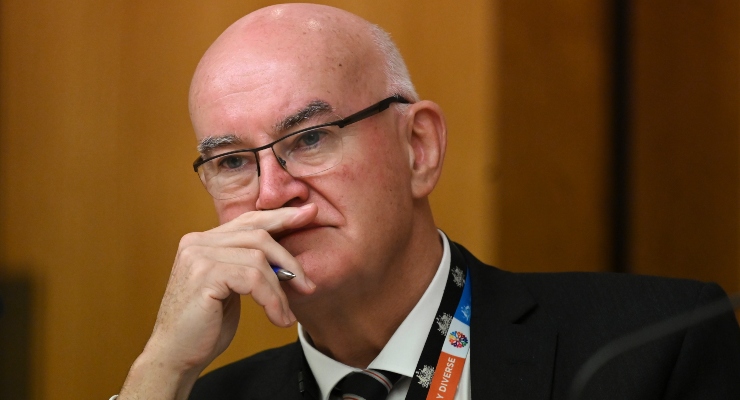
On Wednesday night, the phones of hundreds of thousands of Australians lit up with a breaking news notification about the deaths of two men. Usually, this unfortunate but relatively common event would not inspire widespread media coverage.
But by chance, the deceased were among the 2 million Australians who had received a COVID-19 vaccine. “Two NSW men die after receiving COVID-19 vaccination as TGA begins review,” a headline from the ABC read, with similar coverage across Australia’s media.
If you read the article, it repeatedly states that any link between the deaths and the jab is unproven and would be investigated. As it turns out, there probably wasn’t a link. Australia’s Therapeutic Goods Administration Professor John Skerritt said that “current evidence does not suggest a likely association”.
Of course, that’s not the impression that many would get from reading the initial coverage.
Even while stating there is no proven casualty, the act of saying both facts in the same breath implicitly links the two events. Journalists aren’t writing articles about COVID-19 vaccine recipients who are being hospitalised after being hit by a car.
The editorial decision to cover the deaths is a signal from news organisations that these events are newsworthy in a way that normal deaths are not.
This is not an isolated incident. There have been several blood clot-related hospitalisations and deaths reported in the media following the administration of vaccines (particularly the one created by AstraZeneca), some of which have been determined to be unrelated to the shot.
Why the suggestions?
So why are Australian media outlets choosing to cover the news in a way that suggests a link rather than, say, waiting for the results of an investigation?
Dr Anne Kruger is the director APAC of First Draft, an organisation that works with journalists around the world to combat disinformation. She told Crikey in a statement that there’s a “breaking news rush” to report on blood clot cases in Australia. The reporting had been fuelling fear, leading people to believe that there was a link to the vaccines.
“Mobile alerts to ‘breaking news’ TV stings, the context was lost and provided little information people could use to make judgements,” she said. This creates what First Draft calls a “data deficit”, which is a delay between information and its supply. This happens when an event occurs but it’s some time until an explanation is available.
Even after this data deficit is corrected, evidence suggests that the impact of the initial reporting continues to be felt. For example, the ABC’s article about the initial deaths received more than 25% more engagements than an article about the TGA’s statement across Facebook according to social media analysis tool CrowdTangle.
(Engagements on social media can be viewed as rough proxy for how far this news spreads on the platform, due to the algorithmic nature of the Facebook News Feed.)
Importantly, the initial ABC article was shared by at least one prominent Australian anti-vaccination activist, and continued to be shared even after the follow-up article was posted.
How to report on vaccines ethically
Kruger is unequivocal about reporting the truth about vaccine development and rollout, warts and all.
“People have legitimate questions over these matters that must be attended to. I’m not advocating that the media doesn’t cover these stories, as misinformation will quickly fill the gaps when people type into their search browser and little quality information is returned early in a developing story,” she said.
What journalists need to do, Kruger said, is ensure that everything they produce is properly contextualised.
Headlines present a challenge as their limits mean that it can be difficult to get across the full complexity of an issue. But by their very nature, a headline will reach more people than the contents of an article.
Kruger said that journalists shouldn’t expect their readers to dig into the details, but craft every headline with enough information so that people can understand the full story. This dedication to context should continue throughout coverage, including providing information that allows readers to consider the event’s significance as one part of a broader story about vaccines.








Of course everyone who has their vaccine who dies in future, will have died “After receiving a COVID-19 vaccination…”
Oh no Jimbo, didn’t you hear, anything less than the jab conferring immortality will be regarded as ‘linked’.
“Car crash death attributed to vaccine”
“Car crash death attributed to vaccine”
When people die in a car accident (especially overseas) thier deaths are recorded as Covid if they had any traces.
Too true, James. And it’s not just car crashes and don’t necessarily need traces of covid. India is an example of people not getting access to food and decent drinking water. Of course they die or get very ill and the covid box gets ticked. It’s the ramp of pandemic justification. Same in South & North America and parts of Europe.In India, Monsanto are calling in loans from farmers which hampers food production and distribution. The Govt is also food banking creating massive shortages. I fear a deliberately collaborated holocaust for India and the UN is twiddling it’s thumbs purposely doing nothing.
Here becomes Q 2. FFS its just not true what you are saying. Trump is gone but his echoes can still be heard in the back waters of Crikey.
Cite even one instance of this.
With pleasure -but don’t be so lazy next time -research yourself! Plenty of denials but especially in the USA payments have been made for every positive Covid claim. This from UK.
https://www.thesun.co.uk/news/12714515/coronavirus-death-toll-overcounting/
Oh James, really? This old chestnut? Straight out of the Q playbook AGAIN.
No they’re not.
The vaccinations sceptics seem to be running on emotions, feelings and beliefs.
The real issue on media reporting is not just about Covid, e.g. sub-optimal ‘analysis’ of population/immigration, climate science and real estate, but how many working in media lack critical literacies for analysis including science and data, let alone research process (unless they have done a post grad qual requiring a thesis).
Is that why so many headlines are posed as questions?
The thing that bugs me about the headlines is they’ve turned an incredibly rare occurrence into headline news. This has happened with the vaccines over and over for all sorts of issues (remember the reports about the Pfizer vaccine killing patients in Norway was headline news?) and at some point the effect its having on the public’s confidence needs to be considered. The media outlets do a terrible job of putting these numbers into perspective, which plays into the anti-vaxxers hands.
So here’s to the media and their sensationalism helping to prolong the pandemic…
The photo is captioned “TGA Professor John Skerritt”.
That is not a title he is entitled to use.